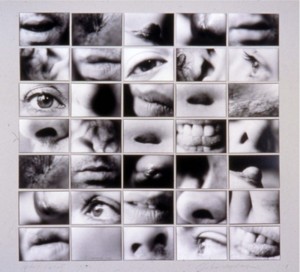
Carolee Schneemann: Portrait Partials
What Feminism Was
“WACK! Art and the Feminist Revolution” is a chance to take a look at the pioneering days of feminism in art, from 1965 to 1980. This huge survey originated at the Los Angeles Museum of Contemporary Art and is now at P.S. 1 – MoMA, Long Island City, to May 12. Capturing the raucous, contentious, feminist diversity, Connie Butler (who in ’05 moved from MOCA to MoMA, where she is now curator of drawings) demonstrates that much of the art by women in this ancient period was superior to dead-end formalist painting and many of the largely male prerogatives of the time.
Without an equal place for women artists, we cut ourselves off from the talents and perceptions of more than half the world. Art, as far as I can tell, is not gender-specific. Hence the effort to rediscover forgotten women artists and the self-consciously feminist art that began in the mid-’60s.
Feminist art, however, cannot be seen as another art-market niche. It may have been an art movement, but it is clearly not a style. Although there were attempts to position feminism as anchored either to centered imagery or, oddly enough, the thoroughly decentered grid, neither trope stuck. Proponents seemed not to notice that both formats had already been readily used by male artists. Certainly some of Georgia O’Keeffe’s flowers can be seen as vaginal, but so are Kenneth Noland’s targets, right? And I never quite understood why grids were particularly womanly. For every association with weaving — which is sometimes a male pursuit too — there’s an association with graph paper and chessboards. I suppose it must have been shocking for certain male artists to find out they were unintentionally making “feminine” artworks.

Martha Rosler: Nature Girls (Jumping Janes)
And Then What Happened?
If the truth be known, feminism in art, as in life, was political, and this is probably why it was suppressed in the ’80s and ’90s. That S-word might seem excessive, but I can think of no other term. It may have outwardly been a benign suppression, frosted over with exhibitions for a few good-girl or bad-girl artists, but look in the galleries now. After so many successful feminist actions by feminist pioneers, the slippage has been appalling. Art history may be cruel, but commerce-driven art is merciless.
We do indeed now have the Elizabeth A. Sachler Center for Feminist Art at the Brooklyn Museum, at the center of which is the permanent display of Judy Chicago’s breakthrough Dinner Party — still controversial, still moving. But in spite of the opening exhibition last year — “Global Feminisms,” curated by Linda Nochlin and Maura Reilly — that attempted to survey feminist art since 1990 — we still need WACK! to gather up the feminist pioneers.
Now more than ever we need their inspiration. Discrimination continues. Here is an appalling example: The inaugural exhibition of LACMA’s Broad Center of Contemporary Art sports only four women artists out of 29. You can blame that on the collecting habits of Eli Broad — currently our favorite whipping boy, since he apparently reneged on his implied intention to give his collection to LACMA — or you can blame whomever approved the less than broad Broad show.
What “WACK!” Lacks
First of all, I would like to point out there is a difference between feminist art and art by just any woman. The uninformed indeed might walk away from “WACK!” thinking that all art by women is feminist.
Perhaps because it is difficult for women to make art?
Doubtful, since half or more of all art students are women, most of whom graduate, which means quite a few people have agreed that they are able to make art of some sort or another — even their male art teachers.
Because it is difficult for women artists to achieve art visibility?
This was certainly the case before the ’70s, and despite that window of opportunity — here honored — we still face that general situation. It is perhaps a tiny bit easier for women artists now, but not much.
And why is this so? Why do male artists dominate the marketplace and its servants, the art media?
I do not blame the critics, who haven’t had much of a say in anything for years. I do not blame the curators; they usually follow the galleries. I do not blame the galleries; the economics of their situation makes it imperative for them to follow the collectors, their customers. These, more than ever, claim power and can threaten to buy directly out of studios at discount prices and even from classrooms. As investors, they go by what they know. No art by a woman has ever gained the astronomical resale value of the art created by males. And yet we know, don’t we, that artmaking is not gender-specific.
The apolitical and anti-activist provisos might apply to male artists too: why aren’t the politically informed works of Hans Haacke or the devastating, accusatory paintings of the late Leon Golub even within monetary spitting distance of any of the current auction superstars? At least, as male art, their work gets shown. Golub, as demonstrated currently at LACMA, was collected even by Mr. Broad.
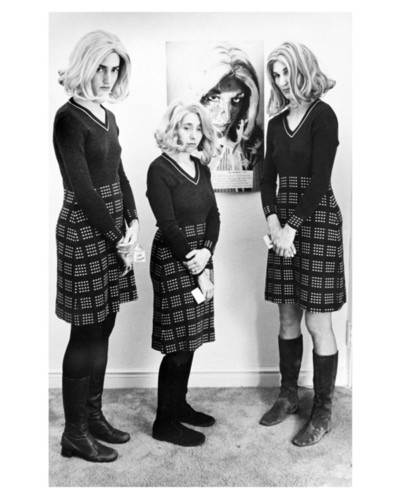
Lynn Hershman: The Roberta Breitmore Series. Photo courtesy Lynn Hershman Leeson.
Why You May Be Confused
It may be clever; it may be subversive; on the other hand, it may be totally fallacious. But curator Butler has a thesis.
Provoked by the dizzying diversity of more than a hundred artworks, the confused viewer might want to take a look at the catalogue, since no wall text clearly explains the incongruent display. Yes, Feminist Art is not a style, but it was — or is? — an art movement.
Butler writes:
Many of the artists in “WACK!” do not necessarily identify themselves or their work as feminist …. It is my contention that — whether unintentionally or lacking the language or cultural context to support a feminist idiom — the artists in this exhibition contributed to the movement and development of feminism in art, if only by reinforcing two central tenets: the personal is political, and all representation is political.
To her credit and armed with some serious catalogue essays, Butler is trying to reexamine feminism in art beyond the well-worn doctrines. Nevertheless, the more one delves into the art selections themselves, the stranger it all gets, so let me offer some clarity.
I do not buy the idea that all women artists, even given the difficulties of achieving both critical and market recognition, are feminists by default. Nor do I think women artists who have profited careerwise by feminist actions qualify as feminist, either. But, to give “WACK!” a positive spin, let us say that the show is about the influence of feminism or which particular art efforts may have fed feminism, rather than about what I or anyone else deem to be the feminism that’s politically correct.
One way to read “WACK!” is to go through the exhibition and try to determine what kind of feminist, if one at all, each artist is:
Feminist by virtue of both content and activism.
Feminist by virtue of activism.
Feminist by virtue of content.
Feminist by virtue of feminist support.
Feminist by virtue of being a woman artist.
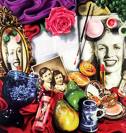
Audrey Flack: Marilyn
Feminists By Virtue of Both Content and Activism
At the top of my list has to be artwork made by a feminist that embodies feminist principles or subject matter. Examples: Judy Chicago’s Dinner Party in Brooklyn and much of the work preceding it; both the early geometric work by Miriam Schapiro at P.S.1 and her later “femmage” (not included). Certainly the performances, photo-pieces and sculpture of Ana Mendieta.
The realist painter Sylvia Sleigh was very active in the women’s art gallery A.I.R. and other feminist causes. Her painting of the members of that fabled gallery certainly counts as feminist, as do her male nudes that turn the tables on the male gaze.
The still underappreciated Lynn Hershman is here represented by her brilliant “Roberta Breitmore Series,” consisting of documentation of how she fully constructed and assumed another identity. Is this about the fact that women must go to great length to construct their personae, even to assume (metaphorically here) a false identity? I call this the Vertigo Effect — after Kim Novak’s masquerade in that Hitchcock masterpiece.
Now more than ever (with a simultaneous array of her photo-collages at the New Museum) it’s clear that Martha Rosler is an artist to be reckoned with — ghastly news images invade consumer-perfect living rooms and kitchens. Outside that picture window or even inside the perfect suburban home is the end of the world.
Nancy Spero is also finally getting her due — in “WACK!,” at the New Museum inaugural show, and in MoMA’s current new-acquisitions survey. Never before have words, images, and politics been so movingly combined.
Joyce Kozloff? She is certainly also a feminist activist. Her work is a riff on Islamic patterning, which as far as I know was itself a male pursuit. On the other hand, patterning insofar as it is associated in our climes with the “merely decorative” has traditionally been considered women’s work. Kozloff’s work, at its best, is therefore quite sophisticated and destabilizing.
And I should also single out for special mention Audrey Flack’s still glorious and still oddly disturbing photo-realist Marilyn.
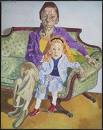
Alice Neel: Linda Nochlin and Daisy
Feminists by Default?
Skipping to the bottom of my list, two possible examples of feminists by default are Louise Bourgeois and Magdalena Abakanowicz. Bourgeois’s bad Surrealism will always remain a mystery to me. Her work unfortunately suggests what some sexist Surrealists thought: a woman’s proper role was as muse, not artist, because women don’t really have a subconscious. Abakanowicz, on the other hand, is extremely talented. But isn’t she a fiber artist and therefore a craft artist? No matter to me; in Artopia we have abolished such sexist and class-based discriminations.
The problem with both artists is that they went out of their way to assert they were not feminists. I guess a woman’s word does not count. Or perhaps they have changed their minds?
Furthermore, the really wacky and to me always interesting Lee Lozano is also included, and there it is, plain as day, in one of her notebook pages on display: “Do not answer any of Lucy Lippard’s phone calls.” During the ’70s, of course, Lippard was a highly visible feminist critic and well within Lozano’s circle of friends. Lozano may have had other reasons for avoiding Lippard, yet she resisted the siren call. No sisterhood for her.
Expressionist portraitist Alice Neel certainly had feminist content when she painted pregnant women, and she gladly accepted the help of feminist artists who successfully petitioned for her first retrospective at the Whitney. But as a Communist (since the ’20s), she could not declare herself a feminist since feminism was deemed a distraction from the struggle of the workers.
And our beloved Hannah Wilke is here too. We appreciate her snapped-together latex wall-pieces in the exhibition, but she’s also represented by her unfortunate 1977 poster: Marxism and Art/Beware of Fascist Feminism. This reminded me of how anti-feminist, anti-sisterhood Wilke actually was. Her personal issue and only issue was that she felt her one-time artist paramour, who had become incredibly famous, had ripped her off artwise. She would not understand that perhaps he got away with it (if her claim were true) because he was a male artist. It was not that the political was personal or vice versa — the mantras of olden days — but that for Wilke the personal, alas, remained personal.
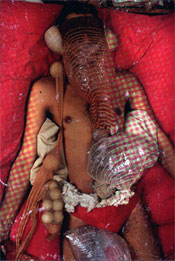
Lygia Clark: Structuring the Self, 1976-81
Is Feminism International?
“WACK!” attempts to be international, like “Global Feminism.” Yet outside the Anglo-American and Northern European worlds, feminism is, as far as I can see, not a major practice. Racism and economic issues of various sorts remain more important. Or none of the above.
Lygia Clark from Brazil? Marta Minujin from Argentina? I admire both, but by no stretch of the imagination can they be considered feminists. Neither, to my knowledge, has directly addressed women’s issues in their art or been an activist in feminist groups.
Nevertheless, please watch the Clark film in the little room devoted to some reconstructions of her astounding work.
Minujin’s mattress hut on the second floor was the site of one of her performances on opening day. Clad in a white jumpsuit, wearing dark, dark sunglasses and using a bullhorn she demanded that those entering the mattress house had to know her name. Well, at least her first name. And as they were let in, they had to shout “art, art, art.” Then the ice cello was delivered, and Minujin proceeded to “play” it, using a saw and a hammer, until it was destroyed. Was the cello a woman’s body? Why was a gentleman inside the mattress house wrapping himself with blue tape like a mummy? I loved it. It was my kind of zany, but I leave it to you, dear reader, to figure out the feminist symbolism — if there is any. In the meantime, I think the doctrinaire Surrealists were dead wrong. Women do have a subconscious, even Minujin.
What Can Be Done?
Feminism in its heyday involved collective action. Why has that been pushed to the background? Because collective action threatens the status quo? Women just might get the idea that the feminist effort needs to be rekindled. The Guerrilla Girls have never given up, but nowadays it looks like everyone else has.
Or was it just exhaustion? There are only so many meetings you can go to. No, I think what happened is that the commercial art world triumphed. Most collectors are conservatives. They have the money. Where did they get it? Therefore, there can be no political aesthetic. Male artists who express a political or dissident bent may be suppressed too, since the art market reasserts ego, profit, product. And the buck goes on.
FOR AN ARTOPIA ALERT FOR EACH NEW ENTRY
SEND YOUR REQUEST TO: perreault@aol.com
John Perreault's art diary
